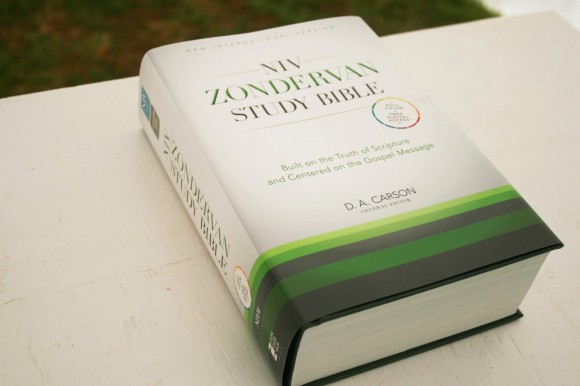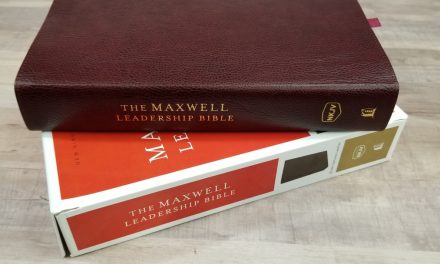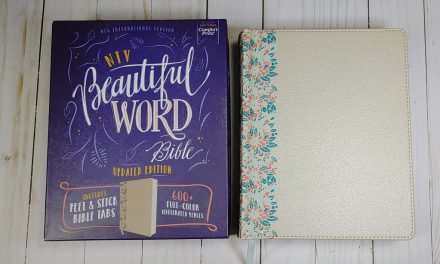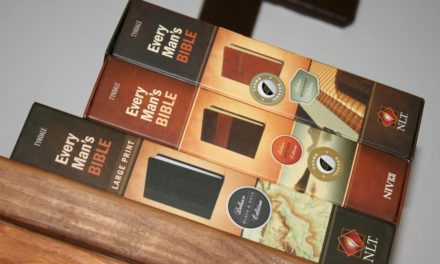The NIV Zondervan Study Bible is the latest in the trend of full-color study Bibles. At 2880 pages, this is one of the largest and most complex study Bibles available. It uses the 2011 NIV text.
Cover
This edition is hard cover. It’s sewn and lays open easily. It’s so large that it actually bends in the spine. I’m not sure if this is normal or not. On a table it isn’t bad, but in my hand it will fold back. This bend does leave a crease. It comes with a dust jacket. The cover itself is gray/brown/green with white lettering for Holy Bible, NIV, Zondervan, etc. The overall size is 6.5 x 9.5 x 2.75.
Paper and Print
The paper is standard paper as found in most study Bibles today. It’s thin but opaque enough that most of the content on the back of the page isn’t distracting. Most of the color doesn’t even show through that much. In some places it’s more obvious than others (it’s more noticeable in poetry).
The font looks to be around 8-point. It’s sharp and has about a medium darkness. It’s consistent throughout. There is a lot of space between the lines – much more than average. It’s black letter. The keys for references and notes do get a little distracting.
This layout really shines. It’s single-column paragraph with prose in paragraphs, poetry in stanzas, dialog is in quotations, OT quotes are almost centered, etc.
The colors are coordinated shades of green that look great together and are pleasing to the eye. The very top of the page has a slight green hue. The section headings, page numbers, and chapter and verse numbers in the header, and verse numbers within the text are a darker shade of green.
References
References are placed in the outer margins. They start where the text starts (sometimes the text starts under a photo) and if there isn’t enough references to fill the reference column, the rest is blank. This gives you a little bit of space for notes on most pages. They’re keyed to the text with letters and the chapter and verses are given for each reference.
Here are a few example references for comparison:
- Genesis 1:1 – Jn 1:1-2; Job 38:4; Ps 90:2; Isa 42:5; 44:24; 45:12, 18; Ac 17:24; Heb 11:3; Rev 4:11
- Matthew 17:20 – Mt 21:21; Mt 13:31; Mk 11:23; Lk 17:6; 1 Co 13:2
- Mark 11:23 – Mt 21:21
- John 1:1 – Rev 19:13; Jn 17:5; 1 Jn 1:2; Php 2:6
- John 2:19 – Mt 26:61; 27:40; Mk 14:58; 15:29
- 1 John 1:1 – Jn 1:2; Jn 1:14; 2 Pe 1:16; Jn 20:27
Footnotes
Footnotes appear under the text, just above the commentary. They’re keyed with letters in italics. At first I thought this might get confusing, but they look enough different from the references so they’re easy to distinguish apart.
Introductions
Sections
Each section of the Bible has its own introduction. This includes large sections (Old and New Testament) and book sections (Pentateuch, The Historical Books, The Wisdom and Lyrical Books, The Prophetic Books, etc.). These introductions include timelines, charts, photos of paintings, places, maps, etc. They discus an overview, the people, places, time, theological perspective, etc.

For example, the overview covers sections of Scripture and gives the references for each section. The overview for the Pentateuch shows Primeval Era (Gen 1-11, Patriarchal Period (Gen 12-50), From Egypt to Sinai (Exod 1:1 – Num 10:10), From Sinai to Moab (Num 10:11- Deut 34:12).
Book Introductions
The book introductions include information about when the book was written, why it was written, the overall context, etc. They are very detailed. The introduction to Genesis is 8 pages and includes the name and purpose, background and author, structure, Genesis and Science, Genesis and History, Genesis and Theology, Genesis and the New Testament, and a comprehensive outline. It also includes a map of the setting and a color photo of a clay tablet.
Notes
Commentary
There are 60 contributors from multiple evangelical denominations that wrote under the direction of D.A. Carson. Notes are placed at the bottom of the page in two columns. They’re maybe a 6-point font (but that’s a guess). The notes’ section is colored with a light olive (ish) color that sets the notes apart from the next. It looks nice.
The commentary is extremely detailed and comprehensive, and of course scholarly. There are almost 20,000 notes. They include theology, historical facts, definitions of the original languages, etc.
The note for Genesis 1:1 for In the beginning says: The single Hebrew word (beresit) denotes the start of a sequence of events (cf. Isa 46:10). The note for God says: God, Hebrew Elohim, used of Israel’s deity and other gods. It describes divinity, power, and the object of worship; it is the only word for God in ch 1, which emphasizes God’s power as creator of the universe. This is only part of the notes for Gen. 1:1.
Typically, the theological notes do not include a wide enough range of perspectives. The notes on culture and artifacts are outstanding, and fortunately there are a lot of them.
Charts, Maps, Photos, and More
There are plenty of full-color charts, highly annotated maps, and photos throughout the notes. They include places, artifacts, drawings of temples, charts of events, charts of people, and lots more. This is one of my favorite tools in any study Bible and this one has plenty to keep me happy. There are hundreds of photos, 90 maps and 60 charts.
Articles
There are 28 articles in the back. They mostly cover theological topics such as Creation, Sin, Priest, Sacrifice, Holiness, The Gospel, Worship, etc. Most are between 2-4 pages in length. Most are written from a scholarly perspective. Some tend to discuss more concept than Scripture, while others include lots of Scripture. They’re helpful for discussion and study.
Concordance
The concordance is 158 pages with 3 columns per page. It has 4795 entries with 36,000 references. 1312 of these entries include every appearance of the word (these are marked with*). It also shows other forms of the word (other forms are given in parenthesis). It shows the entries for the other forms separate.
Here are a few examples of entries with the counts of references given:
- Faith* (faithful, faithfully, faithfulness, faithless) – 258
- Faithful – 92
- Faithfully – 15
- Faithfulness – 68
- Faithless – 12
- God (God’s, Godliness, Godly, Gods) – over 700
- God-breathed – 1
- God-fearing – 7
- Godless – 2
- Godliness – 8
- Godly – 4
- God’s – 30
- Gods – 8
This is a very detailed concordance. If it’s not in here than I probably don’t need it. It’s very helpful for the majority of any study or sermon prep.
Maps
There are 14 color maps that are printed on regular Bible paper. They’re not overly bright but not dull either. They do a good job of showing routes and topography. It doesn’t show a possible Red Sea crossing though. They’re labeled and annotated well. It also includes at 4 page index, so places are much easier to find. Maps include:
- World Of The Patriarchs
- Holy Land and Sinai
- Exodus and Conquest of Canaan
- Land of the Twelve Tribes
- Kingdom of David and Solomon
- Kingdoms of Israel and Judah
- Prophets in Israel and Judah
- Assyrian and Babylonian Empires
- Holy Land in the Time of Jesus
- Jerusalem in the Time of Jesus
- Jesus’ Ministry
- Apostles’ Early Travels
- Paul’s Missionary Journeys
- Roman Empire
Free Digital Access
Owning the printed version gets you free access to the online version. You can search, highlight, take notes, read the articles, notes, maps, charts, etc. This is a $19.99 value. It comes with a code for easy access. You can access it from desktop and mobile devices.
Conclusion
This is a well-designed Bible that’s filled with lots of useful information. It feels to me like a combination of the Archaeological Study Bible and a commentary Bible, which is exactly what I hoped for. I prefer notes based on archaeology, culture, and factual information because I find them less biased and more useful. Of course there is some theological bias (which is expected in a study Bible with theological commentary). As always, use it as a tool and do your own study.
If I described the NIV Zondervan Study Bible in just one word it would be “comprehensive”. Being this comprehensive makes for a rather large Bible. It works great as a study Bible for the home or office. I’m not planning to carry a Bible this large, or use it for general reading, but for study it has a lot of good information and covers a wide range of topics.
Zondervan provided this Bible free for review. I was not required to give a positive review – only an honest review.




































Thank you so much for this review! I have been staring at this one online for some time now just wishing that I could open it up and see what exactly is in it. Thanks to you, I now have a very good idea on what this study bible is all about!
I waited with anticipation for this to arrive. The content has been noted about, but I was most disappointed with the paper. It is creamy colored, not white, and the text and pictures from the other side of the page bleed through much more than I have ever noticed for any other Bible I have had. Check it out in person in a bookshop to see if that will bother you.
Randy,
Thank you for this review. After purchasing the NIV Archeology Study Bible, I thought, it was by far the best study bible in the NIV translation. I have looked intently at the Zondervon SB, I greatly admire and have been edified by the editor (Don Carson ), but wish it had the same paper as the Archeology SB.
Randy,
Just love your reviews! Have you had a chance to review the new (2018) NIV Theological Study Bible? D A Carson is also the editor and it is supposed to have the exact same commentary as the NIV Zondervan Study Bible which is the subject of this review. Seems the 2018 version may be laid out better and has comfort print. Problem is the 2018 version has not been released for sale but you can review somewhat on Zondervan’s website. My question to you is have you had the chance to review the 2018 NIV Theological Study Bible, and if so, how does it compare to the NIV Zondervan Study Bible?
Thanks,
Brad
Thanks Brad! I haven’t seen it yet. It releases in a couple of weeks, so I’m sure I’ll get one soon.
do you mean the study notes from niv archaeological study bible or perhaps the niv cultural backgrounds are included inside the zondervan study bible?
They’re different notes.